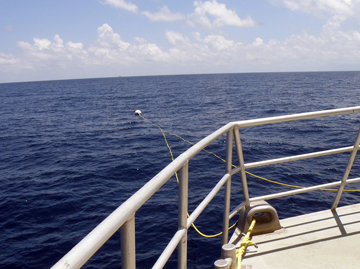INTRODUCTION

How do you protect a resource that is located over 100 miles from land and under more than 50 feet of water? It takes careful planning and continuous monitoring.

The R/V MANTA moored in the sanctuary.
Installing and maintaining mooring buoys helps us prevent anchor damage
to the habitats. Getting the sanctuary designated as an internationally recognized
no-anchoring area minimizes the chance of damage from commercial shipping.
Developing contingency plans enables us to respond quickly and effectively to oil spills, groundings, or other potentially hazardous incidents.
But, it doesn't end there! Appropriate enforcement, permitting, regulations, and public input are all important parts of resource protection, too.